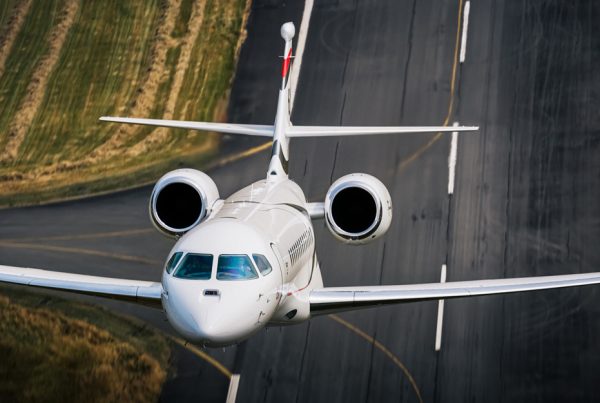
Dassault Aviation Business Jets, Derived From Military Technology
There are many technological developments that have come from military technology. Modern technology like computers, the internet, penicillin, navigation, GPS, air travel and jet engines were indeed born out of military usage, and now adapted for our everyday use and convenience.
Because of its military application, one can be assured that the highest standards of technology have been applied into every aspect of the product. This same adage can be said of Dassault Aviation business jets, particularly with the Dassault Falcon 7X and 8X. The aircraft provide flight beyond first class, coupled with “fighter jet” technology.
Dassault’s Fly-By-Wire (FBW) Technology
Dassault introduced the fly-by-wire (FBW) technology – derived from the Dassault Rafale military fighter aircraft – to the business aviation world with the application to the Falcon 7X, and more recently the Falcon 8X. Dassault’s cutting-edge FBW feature – the Digital Flight Control System (DFCS) – is an electronic driven system which helps ensure the aircraft stays within its flight envelope and it also ensures an ultra-smooth ride with far higher margins of safety than conventional flight controls.
The DFCS features three main flight computers that receives control inputs and direct control movement. These three main flight computers are further backed up by three secondary computers and an ultimate back up in the event of a computer failure – an analog computer which controls the displacement and the trimmable horizontal stabiliser via the pitch trim switch.
These computers permit precise flight path control and they form the brains which handles auto-trim adjustments, optimises the configuration and provides stability augmentation. The DFCS computers also provide built-in flight envelope protection allowing pilots to extract maximum aircraft performance and efficiency without risks of over stressing the aircraft. The computers also monitor flight control inputs and prevents the aircraft from exceeding angle-of-attack, airspeed/MACH or load limits. This feature is invaluable in instances where maximum performance is needed such as when encountering wind shear or doing collision avoidance manoeuvres.
Side Stick Controls
Yet another military derived technology is the fighter aircraft’s side stick controls. Where civilian aircrafts traditionally have control yokes, the side stick controls are used in Dassault Falcon’s newest aircrafts – cementing yet another example of how Dassault has taken military technology and applied it to civil aviation.
The side stick controls offers the pilot the advantages of unobstructed view of the instruments besides having more space to operate. Side sticks moves more rapidly allowing pilots to quickly correct the course of the plane. In Dassault Falcon’s example, the side stick controller also works seamlessly with the aircraft’s fly-by-wire technology where the Digital Flight Control System permits precise flight path control – with the pilot using the side stick controller following a single flight path vector (FPV) cue.
Dassault’s FalconEye & Heads Up Display (HUD)
Dassault’s FalconEye is the world’s first and most advanced combined vision system. Born from military technology, the FalconEye Combined Vision System is the world’s first Heads Up Display (HUD), in business aviation, to combine synthetic, database driven terrain mapping and actual thermal and low light camera images into a single view. The result is an unprecedented level of situational awareness for the pilot and crew. In any conditions of operations, may it be fog, snow, mist and other severe weather conditions, whether day or night, the pilot and crew will always know exactly where they are – providing the approach to every mission with greater confidence.
FalconEye is not just a technological breakthrough and unique in the industry, but it is also the result of decades of Dassault leadership and innovation in the development of modern HUD systems. Today, FalconEye takes the crown by ‘flipping on the light switch’ to a darkened outside world for pilots worldwide with this revolutionary technology developed internally right from the 1960’s – through Dassault’s Mirage IIIB fighter and the continued development and advancements for the civil aircrafts originating from the Dassault Mercure in 1974.
In 2017, the FalconEye technology was nominated (short-listed) for a Collier Trophy, arguably the most coveted and prestigious award in the US for aerospace technology.
FalconBroadcast (Satellite Communications Technology)
FalconBroadcast is derived from the military technology of satellite communications, utilising transmission of real-time data from an aircraft to the ground via a satellite data link.
Utilising this technology, FalconBroadcast is an airborne health monitoring system which provides real time notifications of in flight events and maintenance status. This helps operators begin the troubleshooting process of unscheduled maintenance events while the aircraft is still in the air, allowing them to maximise the dispatch rate of their aircraft for a quicker return to service.
FalconBroadcast is a tremendous leap ahead in the world of business aviation maintenance and troubleshooting, through the use of military technology.
Dassault’s CATIA Software
The CATIA (Computer Aided Three Dimensional Interactive Application) design software was developed by Dassault Aviation for design of its military aircraft and later applied to its Falcon civil aircrafts. The software proved to be useful and powerful that Dassault Group decided to create a spin off company – Dassault Systemes, to further develop and market this software.
The very first aircraft designed entirely with Dassault Systemes CATIA was the ground-breaking Rafale fighter. Fast forward today, CATIA is not only used by other aircraft manufacturers such as Airbus and Boeing, but also in other industries such as shipbuilding, and leading automotive companies around the world.
One of the very key advantages of CATIA is the seamless collaborative process where everyone within the project or even the company could participate with real-time access, anywhere in the world. Taking as an example, the design development of the Falcon 7X where at the peak of the development efforts, over 400 people from 27 companies and seven different countries were working together in tandem on the 3D digital mock up of the Falcon 7X.
In the case of Dassault, these 5 military to civilian technology developments brought about much greater efficiency and safety enabling flying beyond first class – in a “fighter jet”.
































